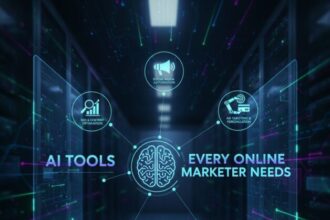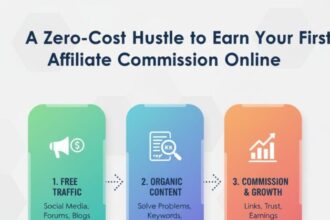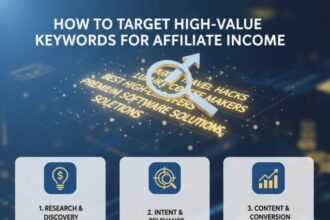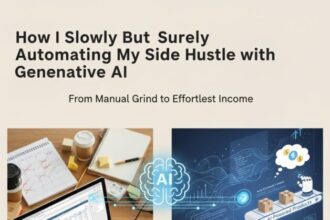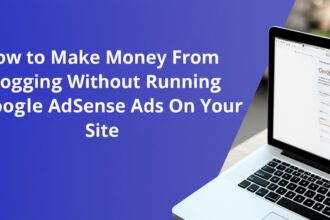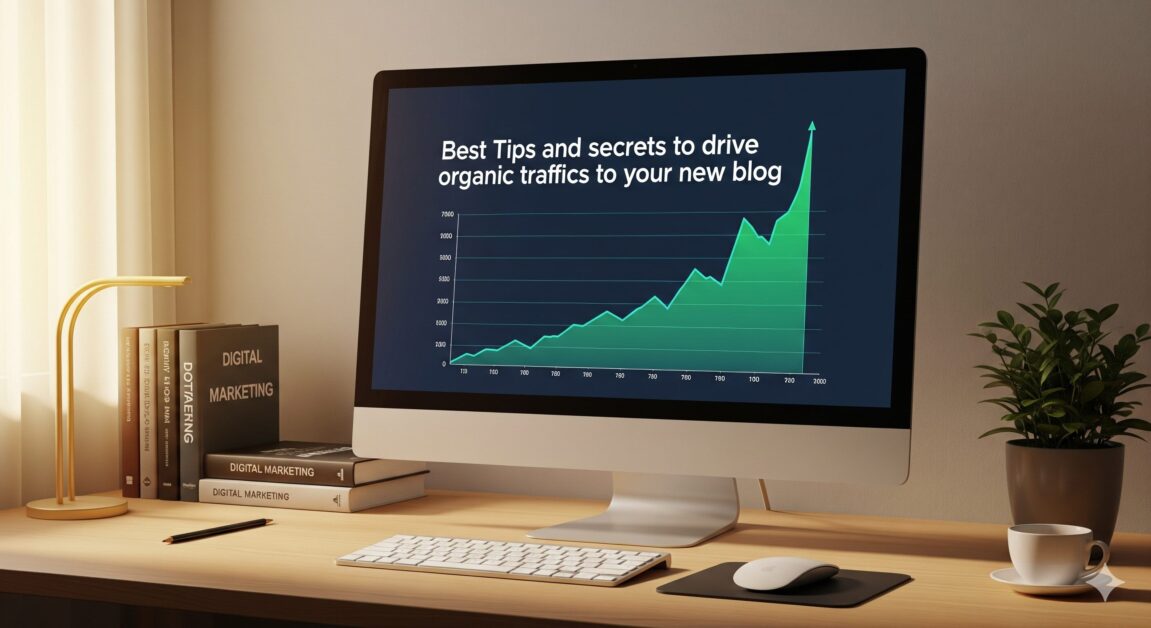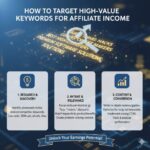- My First 100$: From Zero to Something Real
- Part 1: Chasing the Dream and the Confusion That Follows
- The “Magic Jar” Analogy
- Part 2: Step 1 – Unlocking the Power of Affiliate Marketing
- Part 3: Step 2 – The Long Game with Display Ads
- Part 4: Step 3 – Creating Your Own Product (Even a Small One)
- Part 5: Step 4 – The Power of a Curated Pitch for Sponsored Content
- Part 6: Step 5 – Building Your Email List: The Secret Weapon
- Part 7: The Grand Total and The Road Ahead
- Part 8: The Five Actionable Steps
My First 100$: From Zero to Something Real
It’s an image I can still see so clearly. I was just on my laptop, the screen illuminating my face in the dark. It was late. The coffee was cold. I was staring at a blank analytics dashboard, feeling utterly lost.
I had been told that to get to your first 100$ you just had to start a blog. It sounded so easy. But here I was, months in, with nothing to show for it. The clock read 2 a.m.
I remember thinking, “Is this a joke?” It felt like I was screaming into an empty canyon. No one was listening. No one was reading.
And worst of all, no money was being made. Not a single cent. It’s hard to stay motivated when you’re looking at a big, fat zero.
The dream of making money with a blog felt so distant. It was a goal, but it wasn’t a reality. Not yet, anyway.
It felt like I was doing everything wrong. I was working so hard. But it wasn’t working. It was frustrating.
I’m pretty sure a lot of you have felt this way, right? It’s that moment of doubt. That moment when you wonder if you’ve just been sold a big fantasy. I get it. I’ve been there.
Part 1: Chasing the Dream and the Confusion That Follows
I started my blog with no real plan. It was just an idea. I had some things I wanted to write about. So, I started writing. That’s what you do, isn’t it?
So I began to obsess over traffic. That’s what I thought mattered most. I was constantly checking my numbers. I would refresh the page over and over.
Did anyone visit my site? Were they staying? What were they clicking on? It was all so confusing. I was trying to figure out how to monetize your blog. But every article I read seemed to be written for people who already had a massive following. It felt like I was a kid trying to get into an adults-only club. I just didn’t have the secret handshake.
I think the biggest mistake was that I assumed traffic would magically turn into money. It doesn’t work that way. In fact, it’s not even close. You can get a ton of visitors and still make nothing. Zero dollars. That was a hard lesson to learn.
So, I decided to simplify things. I needed a new perspective. I needed to see the path from a different angle.
The “Magic Jar” Analogy
Imagine your blog is a jar. When people visit your site, it’s like they are dropping a grain of sand into the jar. Your goal isn’t just to fill the jar. That’s what I was doing. I was just trying to get more and more sand.
But what if you could turn a few of those grains of sand into something else? What if you could turn them into a single, shiny coin? That’s the real goal.
It’s not about how full the jar is. It’s about how many coins you can create from that sand.
This is a totally different way of thinking. This is how you start to make money. It’s about focusing on value, not just volume. This shift in thinking was my breakthrough.
My focus changed immediately. I stopped obsessing over traffic. I started thinking about how to create those coins. I started to really look into what people were buying. I began to understand that the sand, or the traffic, was just the raw material. The real work was turning it into something valuable.
I started to read about different ways to make money online. I knew there were many options. I had heard about affiliate marketing for beginners. But I had no idea what it really meant. Was it just a bunch of people selling things to each other? Was it a scam? It felt a little shady at first. But I decided to dive in. I needed to know.
Part 2: Step 1 – Unlocking the Power of Affiliate Marketing
So, I started with what seemed the most accessible: affiliate marketing. I had read so much about it. It seemed like the perfect place to start. I didn’t have to create a product. I didn’t have to handle shipping. I just had to recommend things I already used and liked. It felt so much more genuine.
The first thing I did was find a product I already loved. It was a digital tool for writers. I had been using it for months. I knew it worked. I knew it helped me. So I thought, why not tell people about it?
My first step was signing up for their affiliate program. It was a simple process. I got my unique link. This link was special. It tracked every single person who clicked it. This is how I would get credit for any sales. It was a simple idea.
I decided to write a long, in-depth review of the tool. I didn’t just list features. I talked about my personal experience. I shared the problems I had before using it. I explained how it solved those problems. I was trying to be as honest as I could.
I included my affiliate link naturally within the post. I didn’t just plaster it everywhere. I put it in the sections where it made the most sense. I wanted to be helpful, not just salesy. I think this is a huge mistake a lot of people make. They just want to sell, sell, sell.
Then I wrote a couple of follow-up articles. I wrote a “how-to” guide for the tool. I wrote a post comparing it to other similar tools. Every article was helpful. Every article included my link. I was focused on providing value first. The sale was a side effect of the value I was giving. It felt more authentic that way.
The first sale I made was a total surprise. I was checking my email one morning. I saw a notification from the company. It said, “Congratulations! A user has purchased through your affiliate link.” My heart jumped. It was only a few dollars. But it felt like a million.
It was the first coin. It was proof that the jar analogy worked. My little grains of sand could be turned into something real. It was a small but massive win.
Part 3: Step 2 – The Long Game with Display Ads
I had always thought that display advertising was for the big leagues. You know, for blogs with millions of visitors. I figured there was no way I could get in on that. But I was wrong.
After that first affiliate sale, I started to feel more confident. I began to look for other ways to make money. I had a little bit of traffic coming in. It wasn’t a lot, but it was something. I started to wonder if I could make even a little bit of money from ads.
I did some research. I found out there are ad networks for smaller sites. They work differently than Google AdSense. Some of them have lower traffic requirements. I decided to try one out.
The process of setting up ads was pretty technical. I won’t lie. It took me a little while to get it all right. I had to install a plugin. I had to copy and paste some code. It was a bit overwhelming. But I stuck with it.
I had to decide where to place the ads on my blog. I didn’t want them to be too annoying. I wanted to make sure they didn’t ruin the reading experience. I wanted them to be a part of the blog, not a distraction from it. So I put a few ads in the sidebar. I put one at the end of each post. I wanted a balance.
For the first week, I was obsessively checking my ad dashboard. It was just a few cents a day. I would see figures like $0.05 or $0.12. It was a tiny trickle of money. But it was money. And it was completely passive. It was happening in the background while I wrote new content.
I realized this was the real beauty of it. You set it up once. And then it just works. It’s not a lot of money at first. But it adds up over time. It’s a game of patience and scale.
My daily ad revenue slowly started to climb. It was still small. But it was a consistent flow. It was like having a very slow leak in a pipe. It’s not a lot, but it’s always there. This was my second source of income. It felt pretty good.
Part 4: Step 3 – Creating Your Own Product (Even a Small One)
After a while, I started to get a lot of questions from my readers. They were asking for more specific advice. They wanted to know about a certain part of the process. I started to notice a pattern. People were asking for the same things over and over again.
I had always heard about selling digital products. It seemed so intimidating. I’m not a graphic designer. I’m not a programmer. I didn’t think I could create anything. But I was wrong. Again.
I started to think about what my readers were asking for. The most common question was about how to plan their blog content. They were struggling with organization. They were asking for a simple system.
So, I decided to create a small, simple product. It wasn’t a big, fancy e-book. It was just a printable PDF. It was a simple checklist and a few templates. I spent a few days putting it together. It was a lot of work. But it was also kind of fun.
I used a free online design tool to make it look nice. I didn’t need to be a professional. I just needed to make it look clean and organized. I knew it wasn’t perfect. But it was helpful. And that’s all that mattered.
I wrote a blog post about it. I talked about the problem people were having. I explained how my little checklist could help them. I created a simple payment page. I set the price at a few dollars. It felt a little scary. Would anyone actually buy it?
I launched the product and waited. I was so nervous. It felt so personal. It was something I had made myself. It felt like putting a piece of myself out there.
The first sale was an absolute thrill. It was my own product. Someone was willing to pay me for something I had created. It was an incredible feeling. It felt so different from an affiliate sale or an ad click. It was a direct transaction. It was me providing value and a reader paying for it. That was a big milestone.
Part 5: Step 4 – The Power of a Curated Pitch for Sponsored Content
After my first few successes, I felt a little more confident. My blog was getting a little more attention. I was starting to get a few emails from companies. They were asking about partnerships. I had heard about sponsored posts. But I didn’t really know how they worked.
I did some more research. It turns out, you don’t have to wait for companies to come to you. You can pitch them yourself. But you have to do it the right way. You can’t just send a generic email. You have to be strategic.
I decided to try pitching a company that made a product I genuinely used. It was a brand of tea I loved. I had already written about them organically on my blog. I knew my readers would be interested in them. I knew it would be a good fit.
I crafted a very specific email. I didn’t just ask for money. I explained why I was a good fit for them. I mentioned that I already used their product. I included links to my blog posts. I showed them what my audience was like. I made a clear, compelling case for why they should work with me.
I outlined a specific idea for a blog post. It wasn’t just a review. It was a story. It was a personal piece about how their tea helped me focus while writing. I wanted to tell a story that would resonate with both my audience and their brand.
To my surprise, they said yes. The pay was a little bit more than I was used to. It was a one-time payment. It felt great. It was a new way to make money. It was also a lot of work. I had to create the content. I had to get their approval. But the process was so rewarding. It was proof that my blog had real value. The company saw that value. That was a huge confidence boost.
Part 6: Step 5 – Building Your Email List: The Secret Weapon
I had heard a lot of bloggers talk about email list building. It seemed like another one of those things. It felt like something you did when you were already successful. I was focused on all the other stuff. But I’m so glad I changed my mind. I can’t stress this enough.
I decided to add a simple email opt-in form to my blog. I didn’t have a big, fancy pop-up. I just put a simple box in the sidebar. It said, “Join my community for writing tips.” I also put a form at the end of every blog post. I wanted to make it easy for people to sign up.
I knew I had to offer something in return. People don’t just give you their email address for no reason. So I created a free checklist. It was a simple PDF. It was a checklist for new writers. It was a resource that I knew my audience needed. It was a good first step.
I started to get a few subscribers every week. It wasn’t a lot. But it was a start. I started sending out a weekly newsletter. I didn’t try to sell anything at first. I just shared my newest blog post. I shared a few helpful tips. I responded to every single reply I got. I wanted to build a real relationship with these people.
This is the most important part of the whole process, I think. Your email list is your direct connection to your audience. Social media can disappear. Algorithms can change. But your email list is yours. It’s a direct line to the people who trust you.
I started to realize that my list was a huge asset. It was my most valuable asset. When I had a new blog post, I would send an email. My traffic would spike. When I had a new product, I would tell my list first. They were the most likely to buy. It was because we had built a relationship.
Part 7: The Grand Total and The Road Ahead
So, how did I get to your first 100$? It wasn’t in one big sale. It wasn’t a single event. It was a little bit from here and a little bit from there. It was a small affiliate sale here. A few dollars from ads there. A product sale. A sponsored post. It was a collection of different passive income streams.
I remember sitting down and adding it all up. The numbers were small. But they were real. The affiliate sales were about $30. The ad revenue was about $45. I had made a few sales of my digital product, maybe another $20. And the sponsored post was the rest. It wasn’t a lot. But it was over $100. It was the moment I had been waiting for.
I felt a huge wave of relief. It wasn’t an illusion. It was possible. The dream wasn’t a fantasy. It was just a lot of hard work. And a little bit of patience.
It’s so easy to get discouraged. You see all these stories of people making a ton of money online. They make it sound so easy. But it’s not. It’s a lot of small steps. It’s a lot of trial and error. You have to be willing to fail. You have to be willing to try new things. And you have to be willing to learn.
So, this is just my take. From what I can tell, there’s no magic button. There’s no secret formula. It’s just a process. It’s a process of creating value. It’s a process of building trust.
I think the biggest lesson is that you don’t need a massive audience to make money. You just need to have a small, dedicated audience. You need to provide them with things that genuinely help them. You need to solve their problems. If you can do that, the money will follow. It’s a natural result of the value you’re creating.
And the journey doesn’t stop here. Making your first $100 is just the beginning. The real challenge is to keep going. To keep creating. To keep building. And to keep learning. The process is never really over.
Part 8: The Five Actionable Steps
So, if you’re still at that point. If you’re still staring at a blank dashboard. If you’re still wondering if it’s all worth it. I want to give you a clear path. This is a simple framework. This is the path I took. This is how you can do it, too.
First, identify a product you love. It has to be something you would recommend to a friend. Something you genuinely believe in. Then, find their affiliate program. It’s usually a simple Google search. Look for something like, “[Product Name] affiliate program.” Sign up. Get your link. Write a helpful review or a how-to guide. This is a powerful first step. And it is also a great way to make some extra cash.
Second, sign up for a display ad network. Do some research. Find one that has a low traffic requirement. Place the ads in a way that is not intrusive. You don’t want to annoy your readers. It’s a passive income stream. It’s not going to make you rich overnight. But it will give you a steady, small income.
Third, create a simple digital product. It doesn’t have to be a big e-book. It can be a simple checklist. Or a template. Or a short guide. The key is to solve a specific problem for your audience. Think about what they are always asking for. A simple product is a great way to start. It gives you a lot of confidence.
Fourth, reach out to a company you admire. Find a company that is relevant to your niche. Craft a personalized pitch. Explain why you’re a good fit. Show them the value you can provide. Don’t just ask for a handout. Offer a solution. It’s a good way to build relationships. It can also be a good way to make some decent money.
And finally, build your email list. This is the most important step. Don’t put it off. Offer a free incentive to get people to sign up. It can be a checklist or a short guide. It can be anything helpful. Then, send out a weekly email. Don’t just sell. Provide value. Build trust. Your email list is your most valuable asset.
And that’s it. It’s not a secret. It’s not a get-rich-quick scheme. It’s just a process. It’s just a few simple steps. It’s a slow, steady climb. It feels like you’re not making much progress. But every step matters.
My journey to my first $100 was not a straight line. It was filled with doubt. It was a lot of hard work. But it was also a ton of fun. I learned so much along the way. I hope this helps you on your own journey. And I hope it gives you the confidence to keep going.
Ultimately, it feels like this whole thing is a marathon, not a sprint. You have to be patient. You have to be consistent. And you have to keep your focus on providing value. If you can do that, the rest will fall into place. It may not happen overnight. But it will happen. And that is what really matters.
